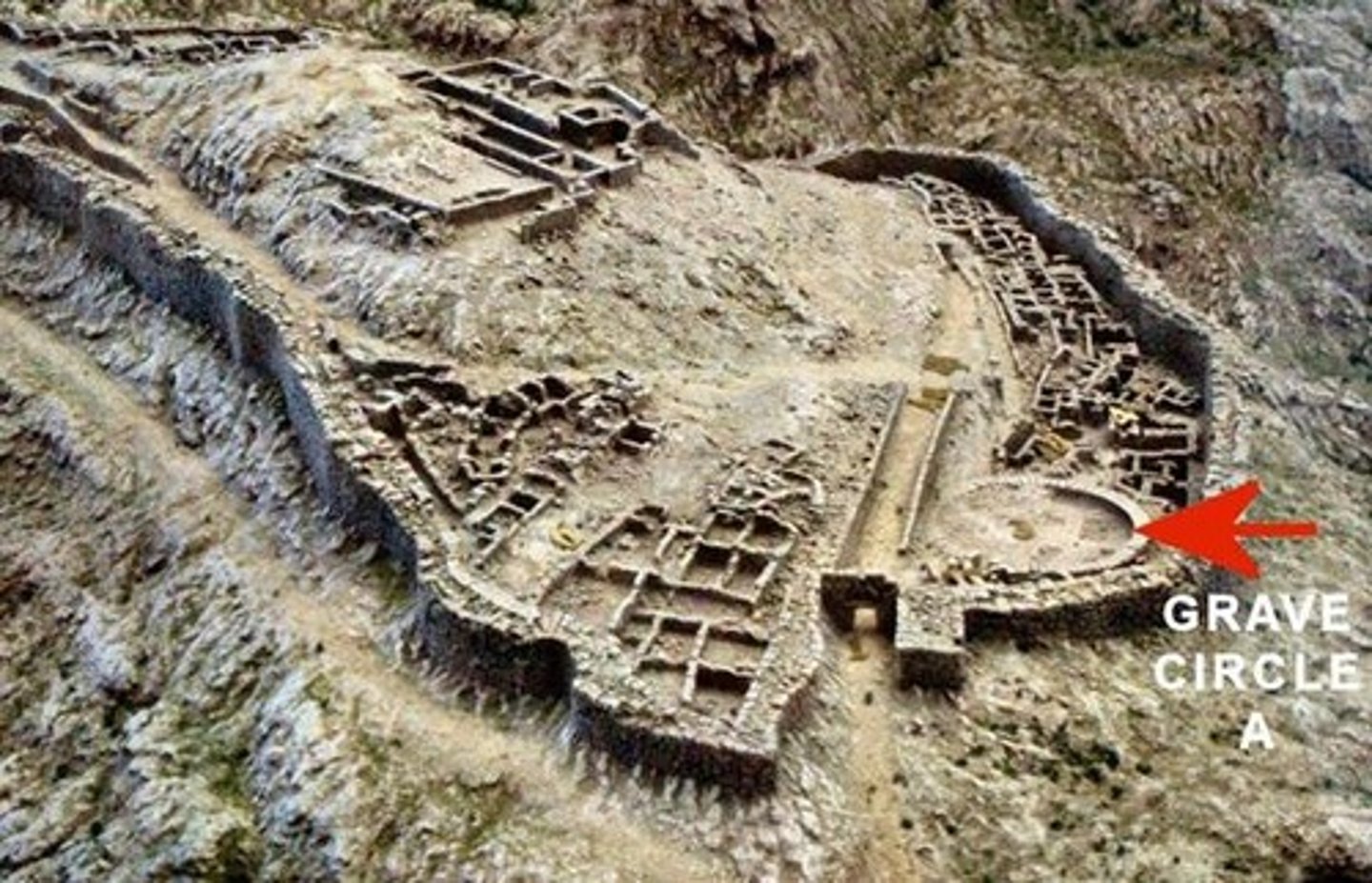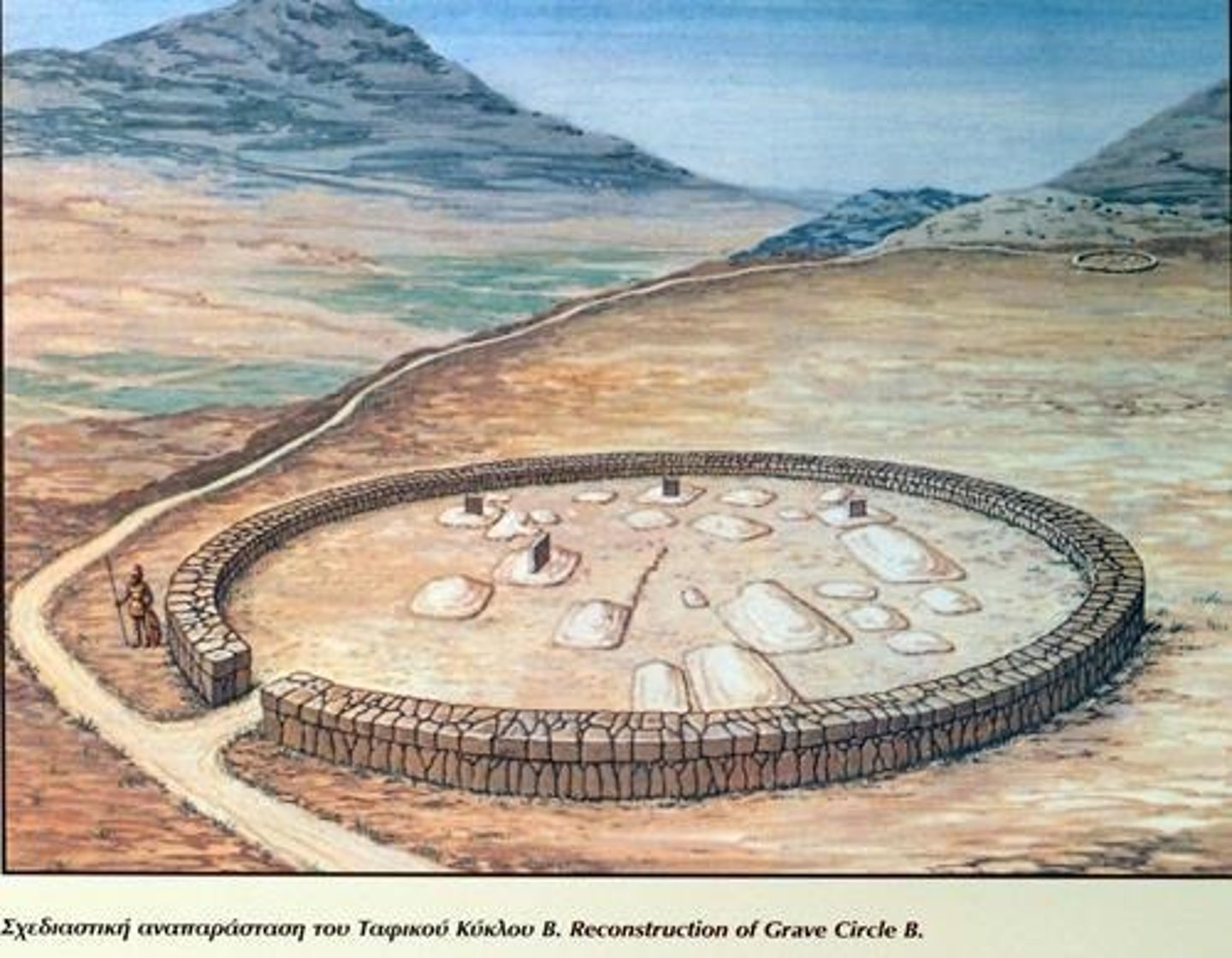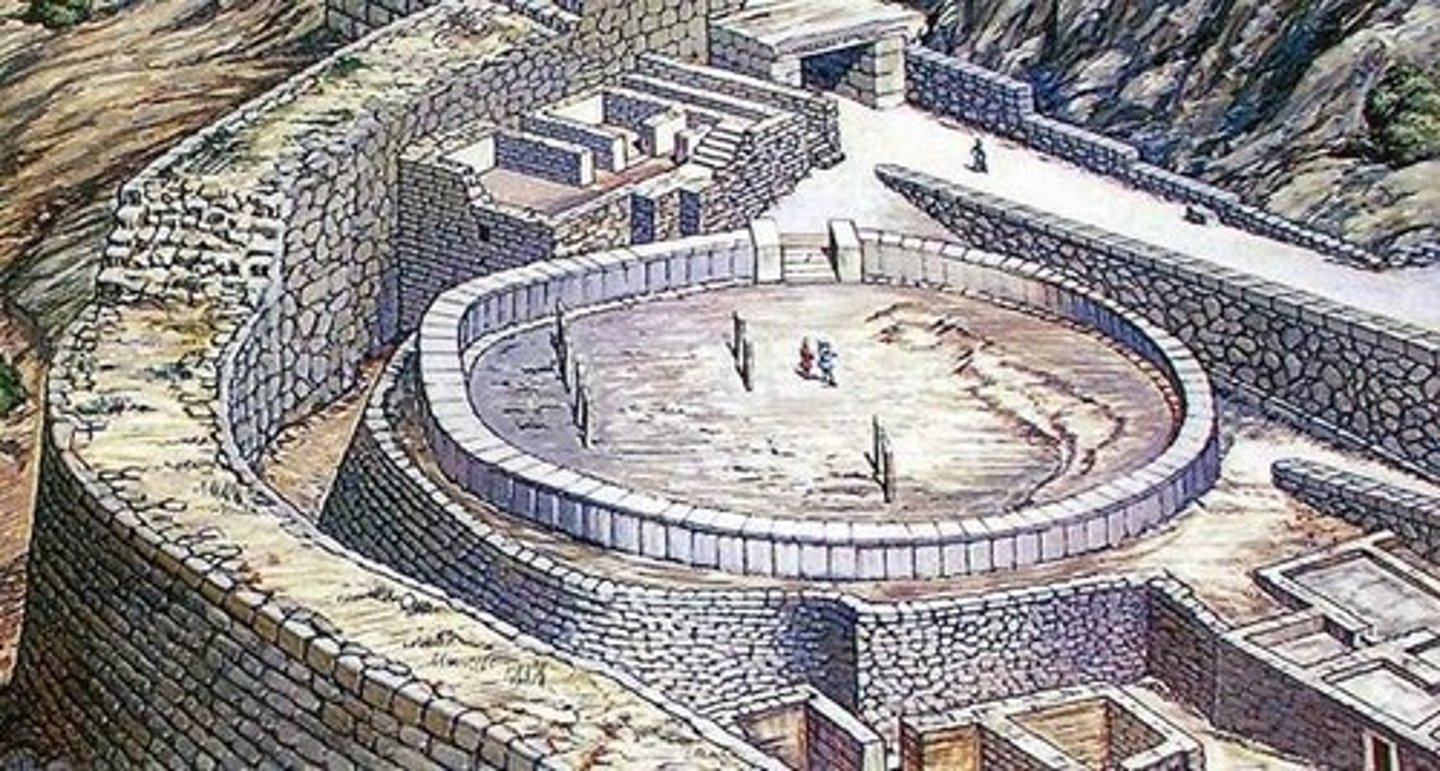Minoan and Mycenaean Cultures Study guide
1/678
There's no tags or description
Looks like no tags are added yet.
Name | Mastery | Learn | Test | Matching | Spaced |
|---|
No study sessions yet.
679 Terms
Myrtos, Crete
An Early Minoan settlement located on the southern coast of Crete, defined by distinctive pottery, advanced urban planning, and the development of trade and cultural connections.
Knossos, Crete
The most famous of the Minoan palaces, serving as the political and religious center of the Minoan civilization.
Throne Room
A central room in Knossos with a large stone throne, symbolic of Minoan religious and royal life.
Shrine and Figurines
Contained in Knossos, these were used for religious ceremonies, with many figurines depicting deities or worshippers.
Frescoes
Brightly colored wall paintings in Knossos depicting scenes from daily life, such as bull-leaping, suggesting Minoan cultural values.
Great Courtyard
A vast open area in Knossos for public events, ritual activities, and gatherings.
Magazines
Storerooms in Knossos for grain, oil, and other commodities, showcasing the palace as a redistribution center.
Linear A
The undeciphered script used by the Minoans for administrative and religious purposes, with symbols representing syllables.
Kamares Ware
A pottery style known for its smooth surfaces, bright colors, and intricate patterns, associated with the peak of the Minoan civilization.
Marine Style Ware
A pottery style recognizable by its depictions of marine life, emphasizing the Minoans' close relationship with the sea.
Tomb of Rekmire Frescoes
Frescoes in the tomb of an Egyptian vizier providing insight into interactions between Egypt and the Aegean world during the New Kingdom.
Minoan Frescoes, Tell el-Dab'a Palace
Frescoes in Egypt reflecting cultural exchanges between Egypt and the Minoans, showing Minoan artistic techniques.
Shrine and Chryselephantine Cult Statue, Palaikastro
A shrine containing a gold and ivory cult statue, reflecting the Minoan's dedication to religious iconography.
Gold Rings with Cultic Scenes
Minoan gold rings depicting religious or mythological scenes, demonstrating the importance of religion in Minoan society.
Limestone Painted Sarcophagus, Ayia Triada
A sarcophagus featuring detailed frescoes and carvings depicting funerary rituals and religious themes.
Aegean Sea
The body of water separating Greece from Turkey, playing a central role in the development of Aegean civilizations.
Cyclades
A group of islands in the Aegean Sea, known for their early Bronze Age settlements and distinctive marble figurines.
Crete
The largest Greek island, home to the Minoan civilization, famous for its palaces like Knossos and its advanced culture.
Knossos
The largest Minoan palace complex, located on Crete, with significant architectural and artistic achievements.
Thera
An island in the Aegean Sea, where a volcanic eruption around 1600 BCE had a profound impact on the Minoan civilization.
Egypt
A major ancient civilization located along the Nile River, known for its monumental architecture, rich culture, and interaction with Aegean civilizations.
Avaris (Tell el-Dab'a)
An ancient city in the Nile Delta, where Minoan influences have been found in art and material culture.
Hellenes
Ancient Greeks, the people who gave rise to classical Greek culture and civilization.
Linear A
The undeciphered Minoan script used for administrative and ceremonial purposes.
Sir Arthur Evans
The British archaeologist who excavated the palace of Knossos and coined the term 'Minoan' for the ancient Cretan civilization.
Minoan Palace
A complex structure used for administrative, religious, and ceremonial functions, such as the palaces at Knossos and Phaistos.
State Formation
The process through which a centralized government or authority develops within a society, as seen in the rise of Minoan and Mycenaean civilizations.
King Minos and the Labyrinth
A legendary figure in Greek mythology, said to have built the labyrinth to imprison the Minotaur. The palace at Knossos is often associated with this myth.
Faience
A type of glazed ceramic, often brightly colored, used extensively by the Minoans.
Fresco
A wall-painting technique in which pigments are applied to wet plaster, commonly used in Minoan art.
Lustral Basin
A ritual bathing structure found in Minoan palaces, indicating the importance of purification in religious practices.
Thalassocracy
A maritime-based empire or sea power, like the Minoans, who controlled trade routes in the Mediterranean.
Redistribution Center
A central location where goods, particularly agricultural produce, were collected and distributed, as seen in the palaces of Crete.
The Theran Volcanic Eruption
A catastrophic volcanic eruption that occurred around 1600 BCE on the island of Thera (Santorini), which significantly impacted Minoan society.
Post-Palatial Period
The period following the fall of the Minoan palaces, around 1450 BCE, marked by a decline in Minoan civilization.
Sarcophagus
A stone coffin, often elaborately decorated, used in ancient burial practices.
Tholos Tomb
A circular tomb with a corbelled roof, typically used by the Mycenaeans for royal burials.
Shaft Graves, Grave Circles A and B, Mycenae
These graves, located at Mycenae, are among the most important archaeological finds of the early Mycenaean period.
Cuirass Tomb, Dendra
A monumental Mycenaean tomb that contained armor in the shape of a human torso (cuirass), revealing advanced metalworking and warrior culture.
Tomb of the Griffin Warrior, Pylos
The tomb of the Griffin Warrior is one of the most important Mycenaean burial sites, containing elaborate grave goods and artistic treasures.
Linear B Documents
Linear B is the script used by the Mycenaeans, a deciphered form of writing that represents early Greek.
Citadel and Tholoi Tombs, Mycenae
The citadel of Mycenae, with its massive walls and impressive architecture, served as a central hub for Mycenaean power.
Tholoi Tombs
Large, beehive-shaped structures used for elite burials, often filled with lavish grave goods.
Lion Gate
One of the most famous examples of Mycenaean architecture, showcasing their advanced stone-cutting techniques.
Egyptian Faience Plaques
Plaques found in Mycenae indicating cultural and trade links between Egypt and Mycenae.
Palace of Nestor
A large Mycenaean palace complex, rich with architectural and artistic remnants.
Ulu Burun Shipwreck
A famous Bronze Age shipwreck discovered off the coast of Turkey, containing a vast array of artifacts from across the Mediterranean.
The Amarna Letters
A collection of diplomatic correspondence between Egypt and other ancient kingdoms, including Mycenaean states.
The Aegean List
A record of various Aegean states and their rulers, found in Amenhotep III's mortuary complex.
Peloponnesos
The peninsula in southern Greece, home to the Mycenaean civilization.
Aegean Sea
The body of water between Greece and Asia Minor, crucial for trade and cultural exchange during the Bronze Age.
Pylos, Mycenae, Argolid
Important Mycenaean sites in Greece, known for their palaces and burial practices.
Asia Minor, Troy, the Hittite Empire
Regions that interacted with the Mycenaeans, particularly in trade and warfare.
Amarna
The capital city of Egypt during the reign of Akhenaten, known for its diplomatic correspondence with Aegean rulers.
Heinrich Schliemann
Archaeologist credited with the discovery of the ancient city of Troy.
Linear B
The script used by the Mycenaeans, an early form of Greek, which has been deciphered.
Wanax
The term for the Mycenaean king, often associated with military and political power.
Basileus
A term for a local leader or ruler in the Mycenaean world.
Lawagetas
A high-ranking military leader or commander in Mycenaean society.
Warrior Burial
A form of burial where individuals, often of high status, were buried with weapons and other grave goods.
Postern Gate
A secondary or hidden entrance to a Mycenaean fortress or citadel.
Cistern
An underground tank used to store water, often found in Mycenaean palace complexes.
Tholos Tomb
A circular, domed burial structure used for elite Mycenaean burials.
Ashlar Masonry
Large, carefully shaped stones used in the construction of Mycenaean buildings.
Cyclopean Masonry
Massive stonework used in Mycenaean architecture, named for the legendary Cyclopes.
The Hittites
A powerful empire in Anatolia that interacted with the Mycenaeans and Egyptians.
Ahhiyawa
The term used in Hittite records to refer to a Mycenaean-like people.
Luwian
An ancient Anatolian language, often used in the Hittite Empire.
Cuneiform
A script developed by the Sumerians, used for writing in ancient Mesopotamia.
Gift Exchange
A diplomatic practice where goods were exchanged between rulers, common in the ancient world.
Mycenaeans
Ancient Greek civilization, c. 1600-1200 BCE.
Heinrich Schliemann
Archaeologist who rediscovered Mycenaean culture.
Homer
Ancient Greek poet, author of the Iliad.
Grave Circle A
Notable burial site in Mycenae, rich artifacts.

Grave Circle B
Another burial site, less wealth than Circle A.

Shaft Graves
Deep burial sites indicating elite status.
Tholos Tomb
Beehive-shaped tomb for elite Mycenaean individuals.

Niello technique
Metalworking method using dark inlays in bronze.
Funerary mask
Gold mask placed on deceased in burial.
Cuirass Tomb
Tomb type with valuable armor, c. 1500-1400 BCE.
Bronze Panoply
Full armor set worn by Mycenaean warriors.
Dendra Armor
Heavy armor found in Cuirass Tomb, Dendra.
Chariot Warfare
Military strategy involving horse-drawn vehicles.
Heroic Warfare
Romanticized concept of battle in Mycenaean culture.
Amber
Fossilized tree resin, imported from Baltic Sea.
Combat Scene Ring
Gold ring depicting battle, found in graves.
Inlaid Dagger
Bronze dagger with gold and silver inlays.
Steely
Sandstone artifact, possibly a weapon or tool.
Rich Agricultural Society
Mycenaeans relied on agriculture for wealth.
Reused Graves
Graves that were repurposed over time.
Meriones
Character from the Iliad, associated with Odysseus.
Boar's Tusk Helmet
Helmet adorned with boar tusks, used in warfare.
Tomb of the Griffin Warrior
Pylos tomb containing 1400+ artifacts, c. 1450 BCE.
Griffin
Mythical creature symbolizing power in tombs.
Seal Stone
Agate stone used for stamping approval.
Minoan Influence
Cretan culture impacting local Pylos artifacts.
Linear B
Script used for Mycenaean administrative records.
Wanax
Title for ruler or king in Mycenaean society.
Lawagetas
Military leader in Mycenaean hierarchy.
Basileus
Minor administrative official, later means king.